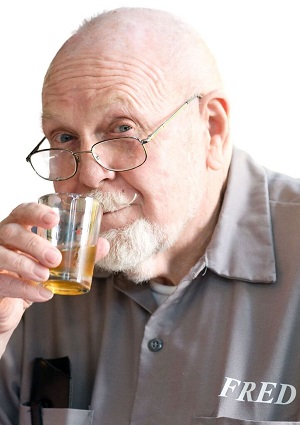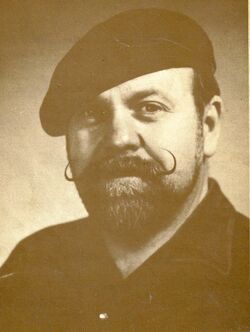Remembering Fred Eckhardt, Dean of American Beer Writing

(Photo courtesy Rogue Ales)
Craft beer lost its muse on Aug. 10.
It was the morning of that day when Fred Eckhardt, 89, died peacefully in his Portland, Oregon, home with several friends by his side. His death left the craft beer community that he helped build with a big, gaping hole in its heart. Journalistic style be damned! I cannot call him Eckhardt. He was and will always be, simply, Fred. With that out of the way, it’s definitely not a stretch to say that if you are enjoying a craft beer today—anywhere in the world, really, you have Fred to thank.
It all started, according to Fred, with a “despicable” homebrew recipe that he would make with his stepfather at the ripe age of 12 (his stepfather brewed it during Prohibition, too). In his last interview, with me and another writer, Steven Shomler, in late 2014, Fred shared the recipe, rattling it off like he brewed it yesterday: “Ten gallons of water … in a crock, of course. Ten pounds of sugar. One package of Fleischmann’s yeast—because that was all we had back then—and a 3.5-pound can of hop-flavored malt extract,” he said. “You make this up and you’re going to get a really raunchy beer. Except for during Prohibition, it wasn’t worth the effort,” he laughed.
“If I had actually had the Treatise out (A Treatise on Lager Beers, which Fred published in 1969, years before homebrewing was legal in the U.S.), which explained how you actually could start from scratch and make a really good beer, Prohibition would have been a total failure. … Prohibition wouldn’t have lasted two weeks if my book had been out because everyone would have been making good beer!”
Fred’s first book was the Treatise, and he cringed when he said the title during that interview in 2014. He explained he had no part in naming the book, “I just wrote it and sent it to the publisher,” he said.
“What would you rather it had been called?” I asked.
“Beer,” he said with a smile and a typical Fred chuckle.
Whatever the name, Fred started working on it for the same reason Fred did most of his inspirations: because he wanted a particular outcome.
“Why did I write it? I wanted some decent beer that I had enjoyed while in the Marine Corps. Even in Japan, they had good beer. This was after [World War II] and the Europeans had good beer and everybody on the planet had good beer except us,” he laughed. “The beer we were drinking was terrible. Bland! When I was in the service during World War II, not too long after we secured the Solomons, we were heading out across Belgium to go to Okinawa. That’s when I discovered beer with character.”
 Back home, Fred pored over German books on brewing to learn more so he could make beer at home. Admittedly, he hadn’t yet made much beer when he wrote the book.
Back home, Fred pored over German books on brewing to learn more so he could make beer at home. Admittedly, he hadn’t yet made much beer when he wrote the book.
“I mostly was making wine at the time,” he said, adding that he had been teaching wine-making classes at the local community college—it was legal to make wine at home, but not beer.
“The only reason I started making beer was because I didn’t want to keep drinking the stuff Coors and Miller were making. I put 33 combinations of good German recipes and techniques in the book. But I still wouldn’t call it a ‘treatise,’ ” he said.
No matter what the name, if you check in at American breweries today, you will often find a dog-eared, well-used copy of that treatise and/or his other book, The Essentials of Beer Style, squirreled away somewhere.
For a long time, Fred beat his “good beer” drum alone, in a country that was still swilling fizzy, light-yellow stuff. But through his contagious enthusiasm, quick wit, infectious humor and joie de vivre, people began to listen. And learn.
After the first book was published, it became clear Fred wasn’t the only one who didn’t want to keep drinking that stuff the large breweries were making. Nationally, and locally in his home state of Oregon, laws changed to allow homebrewing. Fred started writing a couple of newsletters, “Listen to Your Beer” (a famous “Fredism” to this day), which was geared toward beer lovers, and “Talk to Your Beer,” mostly for homebrewers. He wrote beer columns for The Seattle Times and The Oregonian, as well as one for this magazine, which ran from 1986 to 2013. He also began teaching homebrewing classes along with his wine-making course. And he started holding tastings and pairings. At the time, pairing beer with food, unless it was pizza and burgers, was unheard of. Fred was definitely a muse, if not the originator of pairing beer with both chocolate and cheese, and held sold-out pairing events for decades around Portland and across the country.
Through his association with the Houston-based homebrew club, The Foam Rangers, where he served as muse, mentor and a sort of impish mascot, Fred was encouraged to pursue even more esoteric pairings that included breakfast cereals, candies, ice cream and junk food, among other, ahem, inspirations. He at least once paired each course with a Beatles song; another time with classical music—which explained why each plate was adorned with one chopstick: to stand up and “conduct” with Fred!
I asked him once how he came up with pairing beer and chocolate, one of my personal favorites. His answer? “I wanted to eat more chocolate, and I wanted to write it off my taxes!”
Through Portland’s oldest homebrew club, the Oregon Brew Crew, and other venues, Fred became friends with a handful of home brewers who would go on to be craft beer’s pioneers: Kurt and Rob Widmer; Karl Ockert of BridgePort Brewing (now with Deschutes); Mike and Brian McMenamin, who opened Oregon’s first brewpub; and Alan Sprints of Hair of the Dog Brewing, to name a few.
Fred was always researching old brewing books for information on different beer styles and encouraging these fledgling pro brewers to make them, so he could drink them, all the while enticing beer fans to continue their quest for new beers. That spirit is something that is inherent in the craft beer community across the country and around the world today, but Fred was the muse who started it.
One day, while researching beer styles, Fred came across a story about a German beer he had never heard of.
“King Frederick the Great was wandering the countryside, and of course, everywhere he went, they gave him beer, and in Germany there isn’t any such thing as a small glass of beer,” Fred told me. “He was given a huge mass of this strong beer! That was it. I wanted to make this king of beers. I talked to the Oregon Brew Crew, and I did some research [into the defunct style] and found the original gravity and hop bitterness units. Then, I talked Hair of the Dog’s Alan Sprints and his then-business partner, Doug Henderson, into brewing it.”
That, of course, became Hair of the Dog’s flagship, Adambier, now simply called Adam. In 2013, adambier was added as a style in the Brewers Association’s official Beer Style Guidelines.
Of course, a few years later, Alan honored his mentor with his own beer, called Fred. He was always humble, but you could tell by the unmistakable twinkle in his eyes that Fred was very proud of that beer and being its namesake.
In addition to that constant impish gleam in his bright blue eyes, and the way his mouth would always turn up under his trademark neatly waxed mustache, Fred will also be remembered for his kindness, generosity and humility.
During our last chat together (they could never be called interviews, as Fred also was known for his long and circuitous digressions), Fred told me he doesn’t want to be remembered for igniting the craft beer movement.
“Charlie Papazian is your man,” he said.
“But I thought he got started through your recipes,” I countered.
“Well, yeah. They were good recipes. They worked. But Charlie is the one that got all this started.”
“So, your recipes inspired him?”
He nodded. “But Charlie did all the legwork,” he said.
“All I wanted was a good glass of beer.”

Leave a Reply